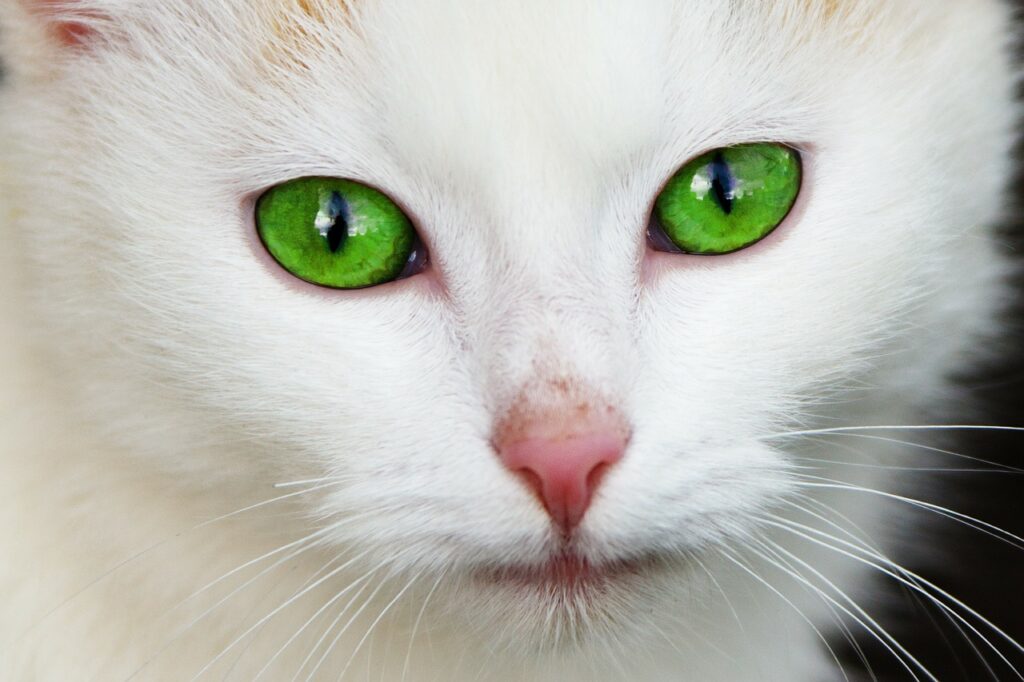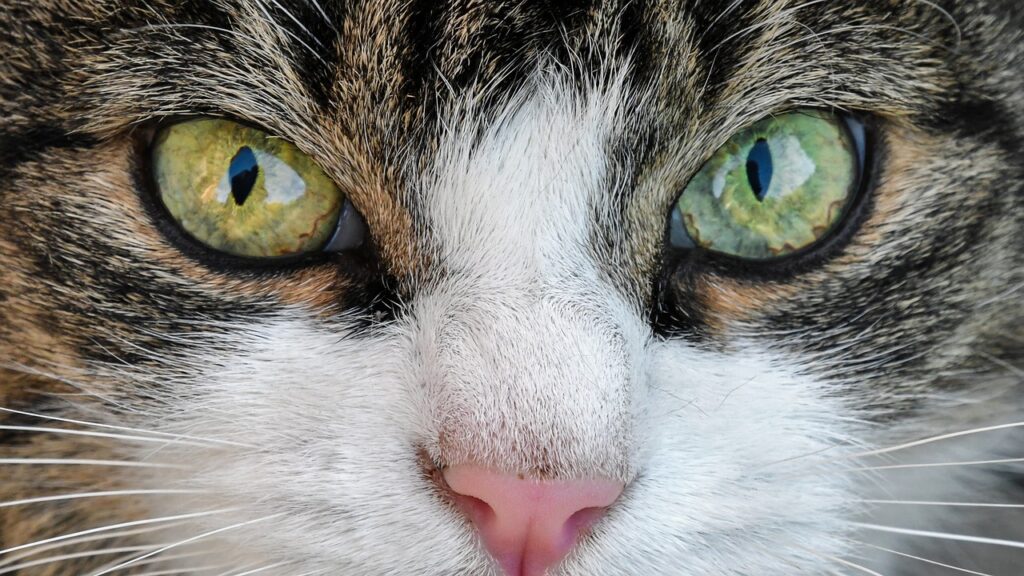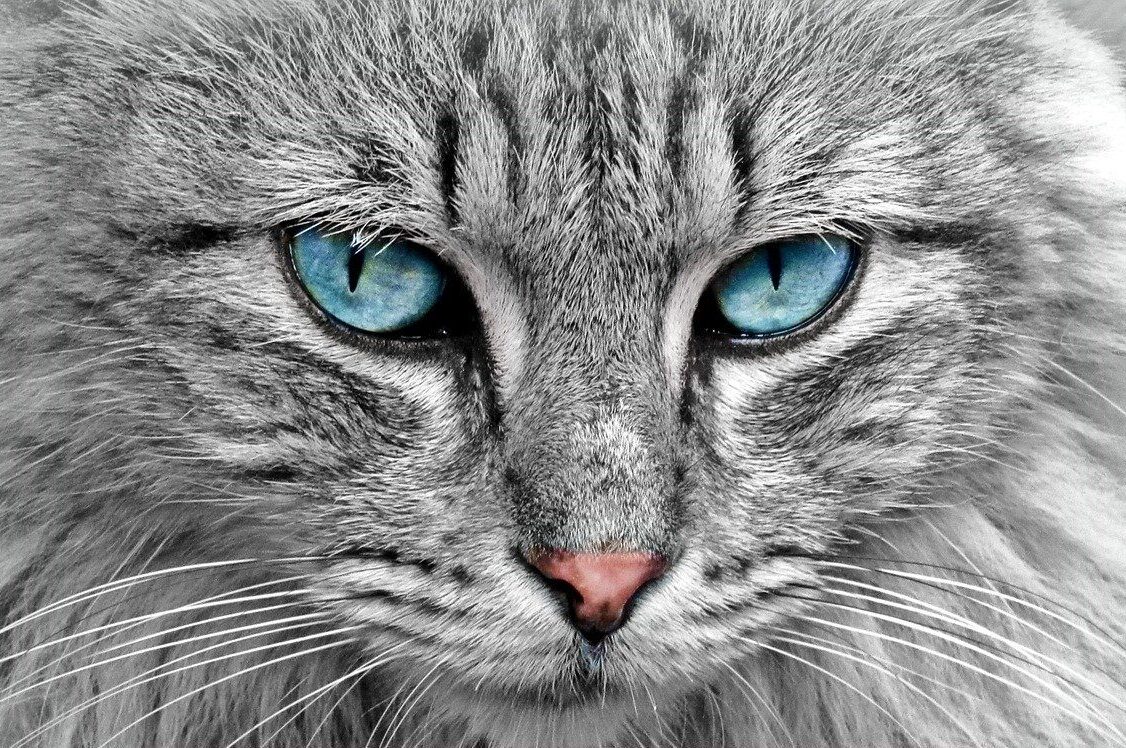The cats’ eye colors are extraordinarily diverse, with greater variance than many other creatures in the wild!
The upright iris of the feline’s eye distinguishes it from practically all other animals in the world.
The pigment of a cat’s eye is determined by the amount of melanin handed down through their genetics from their parents. Melanin also regulates the pigmentation amounts in the skin and hair.
This article has all details about the cat’s eye colors that you need to know.
What causes cats’ eye color to change?
Color originates inside the iris if you’re a human or a cat. The iris, known as the pigmented region surrounding the dark pupil, is divided into two layers, each of which contains melanocytes that are color-promoting cells.
These two layers of their iris are stroma and epithelium, and they transport melanocytes in distinct ways. In reality, the melanocytes in the stromal are distributed, but the melanocytes in the epithelial are highly populated.
Melanocytes in cat’s eyes
The amount of melanocytes in your pet’s eyes controls the eye color. Melanocytes are the cells that generate melanin, which determines the pigment of your cat’s coat.
As a result, the greater melanin your pet has, the deeper its eyes and coat will be.
Melanin, on the other hand, has a different effect on the irises and hair. There is no connection between a feline’s coat color and its eye color, so even though your cat has a darker coat doesn’t indicate her eyes will be darker as well.
What are the different eye colors?
There are different colors of a cat’s eye:
- Blue
- Copper
- Yellow
- Gold
- Orange
- Green
- Red
- Odd-Colored Eyes
Cats with blue eyes
Did you know that the iris can contain no melanin at all? A feline with blue eyes naturally has no melanin in its iris. In fact, a cat’s blue eyes are transparent; however, the blue hue you observe is caused by light reflecting over the curved corners of its color-free irises.
It indicates that a white cat having blue eyes may have zero melanin in its hair or iris. A grey cat having blue eyes, on the other hand, has some melanin in its hair but none in her iris.
As said before, the color of a cat’s hair has no link with the color of their eyes, apart from white cats. It has been discovered that cats with white fur are less seen with blue eyes.
Although you won’t see a cat having red eyes, a cat having blue eyes can emit red color if a bright light is directed onto them, for example, using a phone camera. Felines having orange, gold, or yellow eyes; however, are pretty much guaranteed to glow green when flashed with the light.
Cats with copper eyes
It may startle people to realize that, despite the wide variety of cat-eye hues, you will not see a feline having brown and black eyes.
Even though you may believe you’ve spotted a feline having brown eyes, you’re more than likely gazing at a feline that has dark coppery or possibly reddish-orange eyes. It implies that, regardless of the quantity of melanin in your pet’s iris, the deepest color for your cat’s eyes will be copper.
Cats with green eyes
The majority of cat owners will admit that a feline having green eyes is gorgeous. Green eyes are identical to blue eyes as both of them have a low melanin content.

You could see a white cat having green eyes, or a grey cat having green eyes, or even a brown or black cat having green eyes because various genetics influence the quantity of melanin in your cat’s hair compared with the level of melanin in your cat’s eyes.
Green eyes are among the many attractive eye color variations seen in other cat species.
Cats with yellow or orange eyes
As explained earlier, cat eye coloration is determined by the quantity of melanin in its irises.
With that said, the severity of the pigment will be determined by the amount of activation in the melanocytes.
It indicates that a cat having yellow eyes could have a sharper sight than another cat having yellow eyes and that a cat having orange eyes could have more active melanocytes.

And, as previously said, there is no connection between the color of a cat’s hair and the color of its eyes; therefore, a black cat having yellow eyes is very interesting.
Yellow and golden cat eyes are quite popular, and legendary black cats have also been featured with this gorgeous, blazing look from several centuries.
There is a connection between melanocyte activation and eye color severity in purebred felines as well because these cats were bred for such morphological characteristics.
Since these physical qualities typically involve eye color, therefore, a purebred feline will always have a more vivid eye color than that of a mixed feline.
Cats with odd-colored eyes
Cats with two distinct amounts of melanin production in their eyes are commonly known as odd-eyed cats.
An odd-eyed feline will usually have a blue eye (one without any melanin,) and the other eye could be green, yellow, orange, or copper in color.

This disorder, known as full heterochromia, has been most commonly encountered in white cats, although it can afflict any cat, irrespective of coat color or breeding, provided they contain the white-spotted genetic.
The white-spotted genetic controls the level of melanin produced in cats.
This genetic could also impact the color of a cat’s hair and perhaps even induce albinism, which happens whenever the hair or eyes are completely devoid of pigment.
It’s unclear why some cats acquire heterochromia, but many do not. It seems to be a developmental disorder; although a genetic component may exist, no one knows for sure what produces this odd and magnificent phenomenon.
Although some cat species appear to be more susceptible to heterochromia than many others, but it may impact any feline.
Do odd-eyed cats have low vision?
Heterochromia, fortunately, has no effect on a cat’s vision or hearing. While white cats having one or both blue eyes seem to be more prone to become deaf, whereas non-white felines having a single blue eye don’t really seem to develop any signs of deafness.
It will only be a reason to worry if your pet’s eyes change their color after 12 weeks or even if they tend to change color unexpectedly at any age. A number of disorders can trigger an iris to range in color, but whenever it does, you must contact your veterinarian immediately.
Can cats have one eye with two distinct colors?
Total heterochromia refers to felines with two distinct colored eyes; however, there is also a disorder described as sectoral heterochromia. It occurs whenever a single iris has two or even more shades; for example, one part is blue, and the other is green, and also is caused by an uneven melanin concentration inside the iris.
How can you differentiate an albino cat from a white cat having blue eyes?
If melanin regulates eye and coat color, and overall melanin deficiency is associated with albinism, then you might wonder if a white cat having blue eyes is also an albino cat. It might be difficult to identify an albino cat with a white cat having blue eyes. Pure albino cats, on the other hand, have quite light blue eyes, which often have a rosy or pinkish-blue tint to them.
Due to the deficiency of melanin and also coloration in albino cat’s eyes, that cat would be highly sensitive to light. If you’ve got an albino cat, please keep in mind that sunlight might harm their extremely sensitive eyes, even if they are having little to no health problems.
What eye colors can a black cat have?
Although researchers discovered that existing genetics influence coat color and eye color in felines, but black cats appear to have significantly deeper eyes. It’s quite common to see a black cat having yellowish-orange eyes.
A cat with entirely black fur could have golden or orange eyes. The most common cat-eye pigment in black cats is yellow and orange, while a black cat having blue eyes is rarely seen.
What eye colors can a white cat have?
Spotting a white cat having dark-colored eyes isn’t really unusual, as it is with black cats. The eyes of several white cats could be yellow, copper, green, or blue. It all relies on how much melanin is present in their eyes.
Albino cats, on the other hand, would always feature very soft blue eyes. Since most white cats possess blue eyes; therefore it implies they have no melanin and are light sensitive. Blue-eyed cat pet parents, like albino cat lovers, should always be mindful that harsh sunshine or strong lighting can harm or weaken their pet’s eyes.
Can cats have white or black eyes?
You’ll have a hard time finding a cat having black eyes because the deepest a cat’s eye may become is copper or deep orange. Look more deeply if you happen to spot a cat having white eyes.
It’s possible that the eye is simply a mild blue shade. Your feline is most likely albino if it has white fur and has incredibly light blue eyes.
Do kittens change their eye color when they grow up?
Kittens will always be born having blue eyes. It happens as their melanocyte genes won’t work till they’re a little mature. As kittens mature, their melanocyte genes become more active, allowing the inherent hues of their irises to peek through.

You won’t notice your pet’s eye color transform once she’s approximately 4-6 weeks of age, and you would not be able to detect her complete mature color till she’s almost 4 months old, regardless of what breed or coat color she has.
What eye colors are more prone to have health problems?
Research has shown that cat-eye pigments are linked to a variety of health problems. However, there are a lot of misunderstandings regarding health concerns in cats that have to do with eye color. For example, it’s a widely known misconception that all strange-colored cats are born deaf in one ear.But this is not true; around 20% of odd-eyed felines are born with a disability of hearing. Some could develop deafness as a result of their age.
White cats having blue eyes or any unusual eyes have a greater probability of underlying hereditary deafness from birth, according to research.If a white kitten’s coat contains even a little bit of color change, even if it’s a tiny piece, a mark, or a dot, the odds of hearing are greatly declined. It is possible even if your cat’s distinct color patch fades with maturity, making it entirely white by age.
Abnormal change of eye color in adult cats
Although it’s natural for kittens’ irises to transform color when they get older, it’s not acceptable for older cats’ eyes to do the same. If this occurs, it might be an indication of a condition known as uveitis. Uveitis is an infection of the vascular tunic, which is the colored component of the cat’s iris. Infection of the vascular tunic can produce sudden color changes in your pet’s eyes, which should never be overlooked.
While uveitis isn’t always harmful by itself, it might be a sign of something even more severe, like eye injuries, cataracts, inflammation, systemic difficulties, tumors, or immunological issues. If you observe a difference in your grownup cat’s eyes, then you should get her checked by the doctor right away.
Final Thought
Your cat’s eyes are perfectly gorgeous, no matter what color they are! It’s the unique blend of every cat’s eye, fur, and behavior that makes people fall in love with them in no time.
A cat’s various genetics, melanin amount, and even amino acid influence pigmentation in their eyes and coat. You must keep observing any sensitivity of light or sudden changes in their eye color in adulthood and consult your vet immediately.
References and Further Reading
